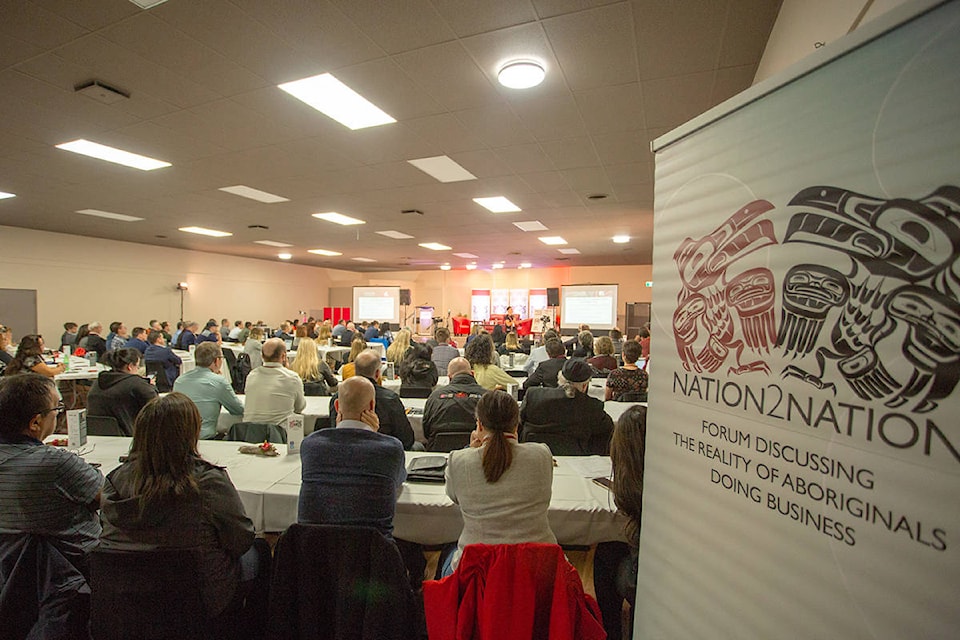Three Northwest B.C. mayors shared the stage earlier this week at the Nation2Nation conference to discuss how municipalities and First Nations can work together to manage the impacts of multi-billion dollar industrial developments.
Since 2015, Nation2Nation has brought First Nations leaders, industry representatives, local politicians and residents together to learn, participate in panel discussions and network with each other on developments in the area. The conference was held from Oct. 23 to Oct. 25 at the Thornhill Community Centre.
Terrace councillor Brian Downie, standing in for Terrace Mayor Carol Leclerc, Prince Rupert Mayor Lee Brain, and Kitimat Mayor Phil Germuth answered questions about their strategies.
READ MORE: LNG panel featured at First Nations business forum
While it’s easy to celebrate periods of economic growth, Downie said there needs to be more support for municipalities adjacent to massive developments.
“It is a serious concern for infrastructure, for transportation services, for social issues… we need the help of senior governments, but particularly people in this room,” he said.
From Kitimat’s perspective, Germuth said when the Rio Tinto modernization project went through in the early part of the decade, the council at that time had decided if there was going to be any delays in the project, it wasn’t because there weren’t enough municipal employees. Without any new tax base, the district hired more police officers, along with fire and ambulance services, while increasing staff for every department.
“We had decided we want to make sure we’re ready for all this and we’re going to do our part. Even though we see the light at the end of the tunnel, that once that tax base is there, that will highly make up for it,” Germuth said.
Brain spoke about Prince Rupert’s view, noting the city is in an “exciting time right now.” Recent numbers from the Prince Rupert Port Authority show the port is doing $50 billion of annual trade, and over the next 10 years, there will be 2,500 direct jobs and another 2,500 secondary jobs coming to the city.
“We’re looking at a population increase of about 8,000 to 10,000 people in the next decade, and we know we will have to build 5,000 housing units to accommodate those folks,” Brain said.
This growth is coming after 20 years of economic decline in Prince Rupert. The city is currently facing an infrastructure deficit of $350 million.
“We’re essentially starting from ground zero, from scratch — not even a penny was saved for infrastructure,” Brain said.
When asked about each municipalities’ planning strategies to manage this, Downie said the City of Terrace has learned from observing the effects of major projects on communities elsewhere.
READ MORE: ‘What’s in it for Terrace?’ City braces for impacts of LNG development
“We were expecting a tsunami of pressures on our community. We don’t know the degree, but we know we’re just in the start,” Downie said.
When talks of a positive final investment decision for LNG Canada’s facility grew a few years ago, city staff began putting a plan in motion by creating a transportation plan to identify the city’s strengths and shortcomings. Staff also looked at Terrace’s parks, leisure services, and made a commitment to increase the number of RCMP officers.
“We’re actually well prepared to make the big changes to accommodate what we think the pressures will be, all we’re lacking is some key support — dollars, essentially.”
Germuth said the District of Kitimat was built around industry development, namely the Rio Tinto aluminum smelter, and was originally designed to hold a community of up to 50,00 people. The problem for the district now is dealing with pressures and demands of land development.
“That’s where the pressures have been on our staff, is trying to deal with all of that rapid growth,” he said.
Brain detailed Prince Rupert’s innovative approach when going through LNG Canada negotiations between 2014 to 2017. The city created a plan looking at major growth scenarios around the world, noting what went wrong and incorporating the lessons into a model to mitigate housing, development staffing issues.
READ MORE: Redesign Rupert holds four-day workshop to reimagine the city
“We spent a year and a half tracking down the right guy and the right team to build a new Prince Rupert. Our view is that we have to build the town from scratch,” Brain said.
Now, the city is rolling out a cross-country marketing campaign with the hopes of attracting and retaining skilled workers.
Partnerships with neighbouring First Nation communities are hugely important for municipalities, the panel agreed.
With B.C. becoming the first province in Canada to introduce a bill implementing the United Nations Declaration of the Rights of Indigenous Peoples, the panel was asked how they will approach their relationships differently with Indigenous communities.
Downie said the City of Terrace has a positive relationship with Kitsumkalum and Kitselas, noting a recent tour of Kitsumkalum’s rock quarry and the city’s commercial joint-venture agreement with Kitselas for the Skeena Industrial Development Park lands by the airport.
READ MORE: B.C. to be first to implement UN Indigenous rights declaration
The District of Kitimat has been happy to build their relationship with the Haisla Nation, Germuth said, while noting there is some work that still needs to be done.
Brain said he would like to see a long-term revenue sharing agreement drafted with Northwest B.C. municipalities and First Nation communities, something similar to the Northwest B.C. Resource Benefits Alliance’s expectations with the province.
The City of Prince Rupert signed a memorandum of understanding (MOU) with Metlakala and Lax Kw’alaams in September, and the city is also working with Kitkatla with the hopes of drafting one with them.
“We’re all part of that community, and we need to build it together,” Brain said.
brittany@terracestandard.com
Like us on Facebook and follow us on Twitter
